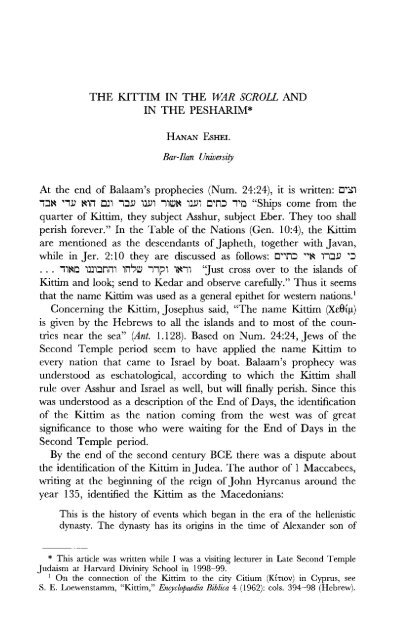historical perspectives: from the hasmoneans to bar kokhba in light ...
historical perspectives: from the hasmoneans to bar kokhba in light ...
historical perspectives: from the hasmoneans to bar kokhba in light ...
You also want an ePaper? Increase the reach of your titles
YUMPU automatically turns print PDFs into web optimized ePapers that Google loves.
THE KITTIM IN THE WAR SCROLL AND<br />
IN THE PESHARIM*<br />
HANAN ESHEL<br />
Bar-Ilan University<br />
At <strong>the</strong> end of Balaam's prophecies (Num. 24:24), it is written:<br />
"Ships come <strong>from</strong> <strong>the</strong><br />
quarter of Kittim, <strong>the</strong>y subject Asshur, subject Eber. They <strong>to</strong>o shall<br />
perish forever." In <strong>the</strong> Table of <strong>the</strong> Nations (Gen. 10:4), <strong>the</strong> Kittim<br />
are mentioned as <strong>the</strong> descendants of Japheth, <strong>to</strong>ge<strong>the</strong>r with Javan,<br />
while <strong>in</strong> Jer. 2:10 <strong>the</strong>y are discussed as follows:<br />
. . . "Just cross over <strong>to</strong> <strong>the</strong> islands of<br />
Kittim and look; send <strong>to</strong> Kedar and observe carefully." Thus it seems<br />
that <strong>the</strong> name Kittim was used as a general epi<strong>the</strong>t for western nations. 1<br />
Concern<strong>in</strong>g <strong>the</strong> Kittim, Josephus said, "The name Kittim ( )<br />
is given by <strong>the</strong> Hebrews <strong>to</strong> all <strong>the</strong> islands and <strong>to</strong> most of <strong>the</strong> countries<br />
near <strong>the</strong> sea" (Ant. 1.128). Based on Num. 24:24, Jews of <strong>the</strong><br />
Second Temple period seem <strong>to</strong> have applied <strong>the</strong> name Kittim <strong>to</strong><br />
every nation that came <strong>to</strong> Israel by boat. Balaam's prophecy was<br />
unders<strong>to</strong>od as escha<strong>to</strong>logical, accord<strong>in</strong>g <strong>to</strong> which <strong>the</strong> Kittim shall<br />
rule over Asshur and Israel as well, but will f<strong>in</strong>ally perish. S<strong>in</strong>ce this<br />
was unders<strong>to</strong>od as a description of <strong>the</strong> End of Days, <strong>the</strong> identification<br />
of <strong>the</strong> Kittim as <strong>the</strong> nation com<strong>in</strong>g <strong>from</strong> <strong>the</strong> west was of great<br />
significance <strong>to</strong> those who were wait<strong>in</strong>g for <strong>the</strong> End of Days <strong>in</strong> <strong>the</strong><br />
Second Temple period.<br />
By <strong>the</strong> end of <strong>the</strong> second century BCE <strong>the</strong>re was a dispute about<br />
<strong>the</strong> identification of <strong>the</strong> Kittim <strong>in</strong> Judea. The author of 1 Maccabees,<br />
writ<strong>in</strong>g at <strong>the</strong> beg<strong>in</strong>n<strong>in</strong>g of <strong>the</strong> reign of John Hyrcanus around <strong>the</strong><br />
year 135, identified <strong>the</strong> Kittim as <strong>the</strong> Macedonians:<br />
This is <strong>the</strong> his<strong>to</strong>ry of events which began <strong>in</strong> <strong>the</strong> era of <strong>the</strong> hellenistic<br />
dynasty. The dynasty has its orig<strong>in</strong>s <strong>in</strong> <strong>the</strong> time of Alexander son of<br />
* This article was written while I was a visit<strong>in</strong>g lecturer <strong>in</strong> Late Second Temple<br />
Judaism at Harvard Div<strong>in</strong>ity School <strong>in</strong> 1998 99.<br />
1 On <strong>the</strong> connection of <strong>the</strong> Kittim <strong>to</strong> <strong>the</strong> city Citium ( ) <strong>in</strong> Cyprus, see<br />
S. E. Loewenstamm, "Kittim," Encyclopaedia Biblica 4 (1962): cols. 394-98 (Hebrew).

















